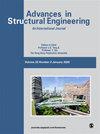Study on time-varying meshing stiffness of helical gears with root crack faults based on improved potential energy method
IF 2
4区 工程技术
引用次数: 0
Abstract
Time-varying meshing stiffness is one of the important excitations of gear transmission system, and its accurate calculation is an important basis for gear dynamics research. This paper proposes an improved potential energy method to calculate the theoretical time-varying meshing stiffness of healthy gears and helical gears with root crack faults, taking into account the non coincidence between the tooth root circle and the base circle of the helical gear, as well as the angle of the tooth root transition circle, the simulation results of KISSsoft were used to verify the rationality and effectiveness of the improved method; analyzed the influence of basic parameters and fault severity of helical gears on time-varying meshing stiffness. The results show that the accuracy of meshing stiffness obtained by the improved method has increased by about 5%; changes in the basic gear parameters cause changes in the contact ratio, which in turn leads to changes in the fluctuation and average value of the gear meshing stiffness; the fluctuation of meshing stiffness is in the minimum value when overlap contact ratio is close to an integer, the fluctuation of meshing stiffness is in the maximum value when total overlap is near an integer; the variation of crack depth and angle leads to local attenuation of time-varying meshing stiffness of helical gears. As the degree of failure increases, the local attenuation of meshing stiffness becomes more pronounce and compared to crack angle, meshing stiffness is more sensitive to changes in crack depth. Compared with the traditional potential energy method, the improved method improves the calculation accuracy of the time-varying meshing stiffness of helical gears, which is highly practical in the accurate calculation of helical gear meshing stiffness excitation and provide the theoretical basis for the calculation of the meshing stiffness of helical gears.基于改进势能法的根裂纹故障斜齿轮时变啮合刚度研究
时变啮合刚度是齿轮传动系统的重要激励之一,其精确计算是齿轮动力学研究的重要基础。本文提出了一种改进的势能法来计算健康齿轮和有齿根裂纹故障的斜齿轮的理论时变啮合刚度,考虑了斜齿轮齿根圆与基圆的不重合以及齿根过渡圆的角度,利用 KISSsoft 的仿真结果验证了改进方法的合理性和有效性;分析了斜齿轮的基本参数和故障严重程度对时变啮合刚度的影响。结果表明,改进方法得到的啮合刚度精度提高了约 5%;齿轮基本参数的变化引起接触比的变化,进而导致齿轮啮合刚度波动值和平均值的变化;当重叠接触比接近整数时,啮合刚度的波动值最小,当总重叠接近整数时,啮合刚度的波动值最大;裂纹深度和角度的变化导致斜齿轮啮合刚度时变的局部衰减。随着失效程度的增加,啮合刚度的局部衰减更加明显,与裂纹角度相比,啮合刚度对裂纹深度的变化更加敏感。与传统的势能法相比,改进后的方法提高了斜齿轮时变啮合刚度的计算精度,在精确计算斜齿轮啮合刚度激励方面具有很强的实用性,为斜齿轮啮合刚度的计算提供了理论依据。
本文章由计算机程序翻译,如有差异,请以英文原文为准。
求助全文
约1分钟内获得全文
求助全文
来源期刊

Advances in Mechanical Engineering
Engineering-Mechanical Engineering
自引率
4.80%
发文量
353
期刊介绍:
Advances in Mechanical Engineering (AIME) is a JCR Ranked, peer-reviewed, open access journal which publishes a wide range of original research and review articles. The journal Editorial Board welcomes manuscripts in both fundamental and applied research areas, and encourages submissions which contribute novel and innovative insights to the field of mechanical engineering
 求助内容:
求助内容: 应助结果提醒方式:
应助结果提醒方式:


